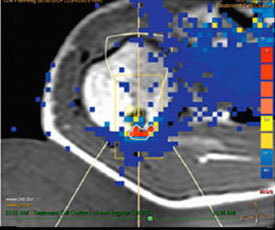
The clinical application of ultrasound has traditionally been diagnostic imaging whereby ultrasound beams are used to construct an image of the object using the reflections from tissue interfaces. However, ultrasound can also be used therapeutically by tightly focusing these beams into a single or multiple focal points using high power levels. High-intensity focused ultrasound (HIFU) therapy is a non-invasive thermal ablation method, which can be used for treating solid primary tumours and metastases located deep within the body. HIFU is established therapy technique which is already in use in several countries globally.
By its definition, HIFU therapy uses high-energy focused ultrasound beams in order to produce a rapid local temperature rise in the focal point(s). Given that the heating duration is long enough, this results in irreversible tissue damage due to coagulative thermal necrosis, i.e. a well-defined lesion to the therapeutic area, while leaving the surrounding healthy tissue intact. The size of this lesion is relative to the size of the ultrasound focal point, which is typically on the order of 1-3 mm in the transverse and 8-15 mm in the axial direction. Therefore, to ablate large tumour volumes, multiple lesions have to be created systematically side-by-side in order to destroy the target volumes reliably.
There are several advantages in HIFU treatment when compared to other cancer therapy methods such as open surgery, chemotherapy and radiotherapy: (i) non-invasive therapies do not have infection risk, which improves the outcome of such procedures with fewer complications; (ii) the recovery from the therapy takes less time leading to shorter hospital stays, and in most cases, the patient can leave straight after the treatment; (iii) there are no known side effects apart from slight heating of the skin in the ultrasound pathway; (iv) the treatment can be repeated as many times as needed because there is no cumulative dose limit for ultrasound. Furthermore, unlike chemotherapy, HIFU can be used to treat any tumour cell types that are susceptible to high temperatures, which makes it an effective therapy method for multiple cancer types.
Although HIFU has several advantages over the alternative cancer therapy modalities, it has also its limitations. The main disadvantage of HIFU is that it cannot effectively penetrate through air gaps or bone, which makes it more difficult to treat tumours located in lungs, bowel, brain or organs behind the rib cage. Another disadvantage is the duration of the treatment due to the ablation of large volumes and skin cooling periods. A typical HIFU therapy treatment time of few hours is comparable to surgical operations, but is generally longer than a radio- or chemotherapy session. Furthermore, HIFU is efficient in treating solid primary tumours, but treating a large number of metastases becomes rather inefficient.